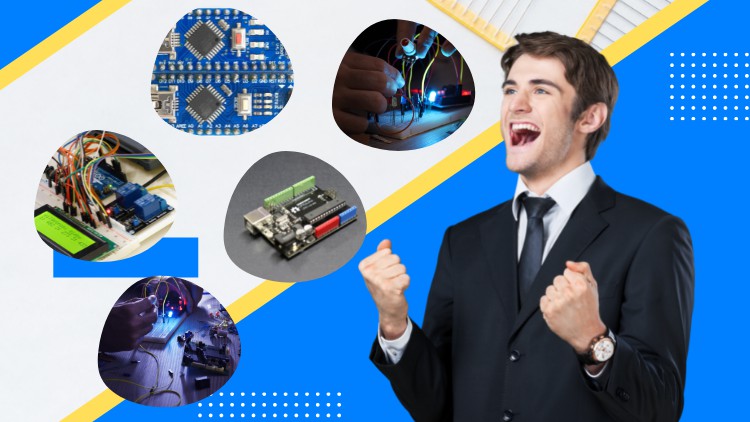Learn Arduino in this 30 Days Challenge: From Zero to Hero
In this 30-Day Challenge, you’ll learn how to use Arduino in a step-by-step practical way and start making things.
What you’ll learn
Learn Arduino in this 30 Days Challenge: From Zero to Hero
- Begin programming using Arduino.
- Find out what you can do to improve your Arduino programming skills.
- In a Windows environment, Arduino UNO, Mega, Nano, and more boards may be simulated.
- Without an Arduino board, you can only write and test code.
- Choose a board that meets your requirements.
- What is the primary difference between the two boards, and why is one superior to the other?
- You can build your own Arduino board.
- Your Arduino has now booted up.
- Find out what an Arduino’s brain is made of.
- Connect an Arduino to a Raspberry Pi.
- Use Arduino as an interface between the Raspberry Pi and heavy objects to protect your Raspberry Pi.
- Using Arduino, you can create your own web-controlled system.
- Learn how Ethernet Shield works and how to operate it through the web.
- The Ethernet shield is connected to the Arduino.
- You can control the Arduino using your smartphone.
- Make a Bluetooth-based home automation system.
- Learn how to make your own radar using UltraSonic.
- Make a weather station of your own.
- Temperature and Humidity Sensors Should Be Recognized.
- You can use Arduino to build your own automatic irrigation system.
- Learn about irrigation systems and soil moisture sensors and how they work.
- Arduino Soil Moisture Sensors Interface
- Connect an Arduino to a Real-Time Clock Module.
- Learn about the Wireless Power Transmission Working Principle.
Requirements
- You must be comfortable with using the Internet.
- You must be willing to put forth the effort rather than simply sit back and observe.
Description
This course will see if you can finish the learning path in 30 days and become a good Arduino programmer.
Making things comes naturally to certain people. This urge to create, on the other hand, might be tough to come by for the more introverted among us. With basic tools like an Arduino starter kit, Arduino makes it simple to get started. It’s no wonder that Arduino boards are swiftly becoming a vital component of the maker community, given how the computer has transformed the worlds of electronics, robotics, and cyber security. Without understanding anything about electronics or coding, anybody can take their ideas from concept to prototype with this single-board microcontroller. Your imagination seems to be the only limit to the possibilities.
So, are you ready?
This challenge will help you master the fundamentals of Arduino programming rapidly! This course will teach you how to make Arduino sketches for real-world tasks. It outlines the necessary hardware and demonstrates how to utilize it. It teaches you how to wire your circuits, code your designs, and more. This tutorial will teach you how to create your own library.
Online Arduino Programming Courses provide a lot of useless material that will inevitably distract novices and make them feel strange when they first enter the Arduino world. This isn’t the case with this task, though.
Create your own Arduino Alarm Clock and set the alarm time as well as communicate with the time and date properly.
This course will show you how to make your own Arduino Alarm Clock, set the alarming time, and interact with time and date variables efficiently and effectively. This guide will walk you through each component in the circuit, explaining what it does and how to wire it up, starting with the RTC DS3231 Time and Date Module and ending with resistors.
You’ll learn what the RTC Module’s true working principle is and how to interface and configure it appropriately so that you can create an Arduino-powered alarm system that can display time and date as well as trigger alert action.
Using an Arduino, we’ll set the required alarm time inside the code. The time and date values will be handled by the RTC Module.
Create your own Arduino wireless power project and learn how wireless power works.
This course will show you how to make your own Arduino Wireless Power Transmission Project and use wireless power to light electronic components and devices more efficiently and effectively. This guide will show you what each part of the wireless power transmission circuit is, what it does, and how to wire it up, starting with the winding coils and ending with simple things like a resistor.
You will learn how wireless power transmission works and how to use, connect, and configure Arduino correctly so that you can make your own Arduino Wireless Power Transmission device, too.
Before the end of this class, you will be able to make your own wireless power transmission device. You can use it for any application that comes to your mind.
The goal of this class is:
Make your own Arduino project that sends wireless power and learns about the principles of wireless power, too.
This course will teach you the following:
– How to transform an Arduino into a wireless power transmitter by connecting it to other electrical components.
– How to use Arduino to connect various sorts of electrical components.
– Learn how Arduino can help you live a better life.
– How to program an Arduino, burn a code, and connect it to coils.
– What are the necessary tools to begin creating remarkable projects?
Bluetooth-Controlled Multicolor RGB LED Lamp by Arduino
This tutorial will teach you how to use Bluetooth to connect the Arduino to a mobile app and control RGB multicolor LEDs.
This course will introduce you to mobile apps, Bluetooth Control, RGB LEDs, and how to interface all of these items to produce an amazing output that you can show off to your friends and brag about. This will really help you add something cool to your collection of projects that you’ve already made, or even to your office.
This tutorial will teach you how to use Bluetooth to connect the Arduino to a mobile app and control RGB multicolor LEDs.
There is a lot of useless material in online Arduino Programming Courses that novices will find hard to focus on and make them feel uncomfortable when they first start working with Arduino.
This course was created to assist novices in the Arduino world by the teacher, who is a highly-skilled hardware engineer with a solid foundation in Arduino programming.
At first sight, RGB (Red, Green, Blue) LEDs seem to be conventional LEDs at first sight, but there are really three LEDs within the standard LED package: one red, one green, and yes, one blue. You can blend almost any color by changing the brightness of each of the tiny LEDs.
By altering the brightness of each of the three LEDs, we mix colors in the same way we mix music on a “mixing board” or paint on a palette.
Prepare to be amazed by colors you’ve never seen before.
You don’t need any previous expertise, and all you’ll need is an Arduino and a few basic electrical components.
This course is for anybody who is interested in Arduino but has no prior experience.
Who this course is for:
- Anyone with even a smidgeon of an interest in creating amazing things.
- If you want to learn Arduino but don’t want to buy the boards, this is the place to go.
- developers of hardware.
- Anyone who wants to learn about Arduino Web Control.










